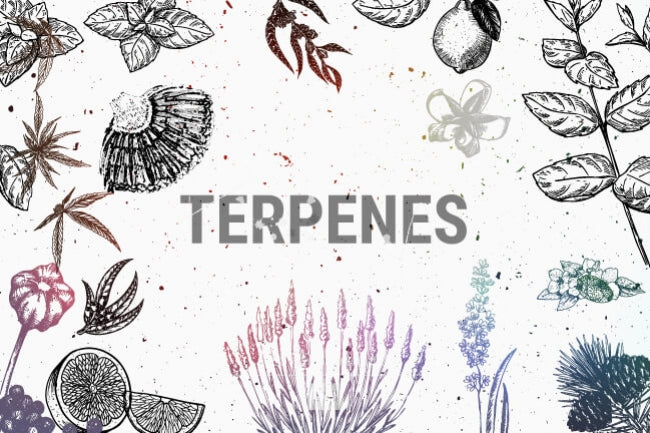What are Terpenes and what do they do?
Terpenes are produced by a wide variety of plants and often have a strong unique smell. It is the terpenes found in cannabis and hemp that give the plant that unmistaken smell. However apart from just a strong smell, these terpenes have proven to provide a wide range of benefits that keeps growing as more research is done.
What are Terpenes?
Terpenes are naturally occurring organic hydrocarbons in the essential oils of plants, including cannabis. Scientists have discovered more than 20,000 terpenes including over 200 types in various cannabis and hemp plants. They give each plant a unique terpene profile.
In the cannabis plant, terpenes are produced in fine, hair-like extensions, called trichomes, found on the buds and leaves. The terpenes repel insects and animals, preventing the need for insecticides.
It is important for farmers to gently handle the plants during collection, storage and processing. If the trichomes remain unbroken, the farmers end up with high quality cannabis that has strong and distinct colours, aromas and flavours.
What is the difference between a terpene and a terpenoid?
People generally believe that terpenes and terpenoids refer to the same thing, but they are slightly different.
Terpenes naturally occur in plants and help people to identify cannabis strains. Their quantity is significantly influenced by temperatures, humidity and light intensity. That is why standardised growing conditions for medicinal cannabis is emphasised by growers.
Terpenoids are the result of modifying terpenes through drying and curing. The process changes the oxygen content of the compound, changing its taste and the aroma. Terpenoids are used extensively to create essential oils, spices and perfumes.
Health Benefits of Terpenes
Terpenes contribute to the varied hemp plant makeup and potential benefits. The differences between the 200 different terpenes found in hemp plants can be quite subtle but, in some cases, they are huge. Below are some of the most common terpenes found in hemp and their effects on humans.
Beta-Caryophyllene naturally occurs in rosemary, black pepper, hops and cannabis. In the body, it targets the CB2 receptors of the endocannabinoid system, meaning that it doesn’t have psychoactive effects. It reduces inflammation and protects the digestive system.
Eucalyptol is found in hemp, eucalyptus, wormwood or rosemary oil. It has a fresh mint fragrance, which makes it suitable and popular for use in cosmetics.
Bisabolol has a light, sweet floral aroma and is known to have antimicrobial, anti-inflammatory, and anti-irritant effects and has proven capability to support the death of acute leukaemia cells.
Camphene is found in cannabis, rosemary, lavender, nutmeg, sage, camphor, tulsi, valerian, ginger, cypress, neroli and citronella. Its camphor-like aroma, generally thought of as a “funky” smell, has a dank pungency mixed with subtle sweet undertones, typical of a wet forest floor in spring. It is antibacterial, antiviral, antifungal and has been found to be helpful for psoriasis, eczema and other skin conditions. It is an expectorant and it reduces oedema. Research found it to reduce cholesterol and triglyceride levels, making it great for preventing heart disease.
Geraniol (or lemonol) is found in some types of cannabis, lemongrass, peaches, roses, geranium, coriander and lemons. It has rosy, floral notes. It is antiviral, antibacterial, kills cancer cells, antioxidant, protects against nerve diseases, and relieves spasms. It used a lot as a fruity flavouring agent, as a mosquito repellent and is included in bath and body products.
Guaiol is found in some cannabis plants, pine, cypress and guaiacum. It has piney and woodsy aroma with rose petal undertones. It is antioxidant, reduces inflammation, supports digestion and immune system, lowers blood pressure, and relieves pain and spasms. Research has found it to be strongly antimicrobial and insecticidal. It is possibly responsible for guaiacum’s historical use for curing syphilis, gout, sore throat, rheumatism, etc.
Humulene, which occurs naturally in cannabis sativa, clove, basil and hops, has a delicate earthy, woody aroma with spicy herbal notes. It is well known as a strong anti-inflammatory agent and a hunger-suppressant. Some people know it for its anti-bacterial and cancer-killing effects.
Limonene is responsible for the fruity smell in citrus-smelling cannabis, orange, lemon, lime and other citrus fruit rinds. It. It is used a lot as a fragrance in cosmetics and cleaning products, where it provides the citrus smell. It is generally known for its antibacterial and antifungal properties which is why some people use it to treat toenail fungus. Its role on the cannabis plant is to repel and kill insects. It enhances the absorption of other terpenes through the digestive tract, the skin and the mucus membranes. Medicinally, it relieves stress and depression, improves the mood and generally energizes.
Linalool, which commonly occurs in lavender, has a light and floral aroma. It relieves depression, stress, anxiety and seizure symptoms. It also induces sleep (sedative) and it brings relief to people suffering from psychosis.
Myrcene is one of the most plentiful terpenes found in cannabis. It is important for growers and users because it helps them to determine whether a cannabis strain is sativa or indica. According to experts, a plant containing more than 0.5% myrcene will have indica-like effects, while one with less than 0.5% myrcene will produce sativa-like effects. The terpene is also found in lemongrass, thyme, hops, and mango.
It is well-known, and widely used, for its analgesic (pain killing) and antibiotic properties. It reduces inflammation, kills cancer cells and induces sleep. It also prevents mutation and increases the effects of THC.
Ocimene occurs naturally in hemp, basil, pepper, orchids, mangoes, mint, kumquats. It has a sweet, herbaceous, woodsy aroma that is popular in perfumes. In plants, it plays a defence role and prevents fungi.
Pinene: There are two types of pinene that naturally occurs in pine trees and certain herbs. Alpha-pinene, the smell of pine needles, is quite abundant in nature and has therapeutic and energetic effects. Beta-pinene, the smell of parsley, basil, rosemary, and dill also occurs in confers, citrus peels and turpentine.
When eaten or inhaled, pinene quickly crosses the blood-brain barrier. It relaxes the bronchi to improve airflow to the lungs, improves memory, wakes up the brain, and reduces inflammation. When used on the skin it is a local antiseptic. Because of the many healing properties, it was used by many cultures for thousands of years.
Terpinolene is naturally present in small amounts in plenty of cannabis strains. It carries a range of smells such as herbaceous, floral, piney, and even citrusy. You can even describe its smell as “fresh” which is it is widely used in soaps and perfumes. This terpene is also found in cumin, tea tree, nutmeg, lilac, and apples. While the compound never plays a leading role, it plays a key role in defining the taste and smell of many cannabis strains. Its effect on humans is slightly anti-bacterial, anti-cancer, sedative and anti-oxidant.
Terpineol occurs in over 150 plants including lilacs, pine, lime blossoms and cannabis strains that contain lots of pinene. It has a pleasant lilac smell. It is popular in soaps, lotion and perfumes. It is known for having relaxing, antioxidant, antibacterial, anti-tumour, antimalarial, sedative, and anti-inflammatory properties.
Valencene is found in some types of cannabis and Valencia oranges. It contributes to the citrus sweet aroma of cannabis. It is known to repel ticks and mosquitos. It is known to be anti-inflammatory. Other effects are being researched.
How Terpenes Work
In a paper released in 2011, a team of scientists explained how terpenes moderate the effects of THC and other chemicals in the body as they interact with receptors in the endocannabinoid system (ECS). Terpenes work in synergistically with cannabinoids in what is now called the entourage effect, with effects that vary from terpene to terpene.
Scientists have made a lot of progress in classifying terpenes and their effects. There are four broad categories: sweet, bitter, sour, and spicy. These are broken down further into more specific smells that are linked to certain strains and the properties of those strains. For example, a flower may have a strong lemony scent which is generally linked to strains like lemon skunk and lemon haze which give users increased energy and euphoria.
As you learn more about different terpenes and how they relate to scents, you can easily determine the properties of each plant that you encounter by simply smelling it.
Terpenes are the expert’s approach to cannabis which used to help people make decisions based on the typical characteristics and effects of sativas and indicas. Scientists have now helped us to know that terpenes greatly determine the flavour and aroma of buds. They also alter, boost or modify the intensity and duration of the effects of each strain.



Leave a comment